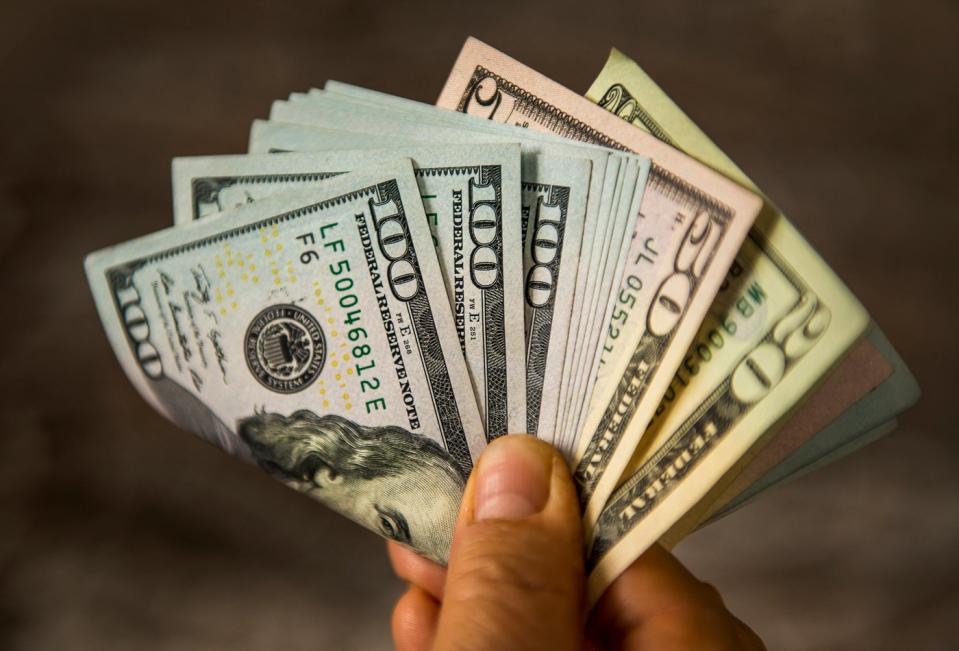Wall Street offers investors an assortment of pathways to make money. However, few strategies have been more successful over the long run than buying and holding dividend stocks.
Last year, Hartford Funds released a report that thoroughly examined the ins and outs of dividend stocks over extended periods. In particular, a collaboration with Ned Davis Research found that income stocks averaged a 9.18% annual return over a half-century (1973-2022), with dividend growers and initiators really packing a punch (10.24% annualized return). For comparison, the annualized return of the equal-weighted S&P 500 came in at 7.68%, while the average annual return of non-payers was a mere 3.95% over the same timeline.
Hartford Funds' findings shouldn't be all that surprising. Businesses that pay continuous dividends tend to be profitable on a recurring basis and, in many instances, they can provide transparent long-term growth outlooks. In short, they're just the type of companies you'd expect to see grow in value over lengthy periods.
However, no two dividend stocks are cut from the same cloth. If investors want truly safe annual income, their best bet is to search among Wall Street's Dividend Kings. A Dividend King is a company that's raised its base annual payout for at least 50 consecutive years. Chances are that if a business has increased its aggregate payout for a half-century or longer, it's a time-tested operating model.
If you want $1,000 in ultra-safe annual dividend income, simply invest $19,000 (split equally, three ways) into the following three time-tested Dividend Kings, which sport an S&P 500-trouncing average yield of 5.26%.
Johnson & Johnson: 2.96% yield, 61 consecutive years of dividend increases
The first Dividend King that can provide exceptionally safe and consistent income from a starting investment of $19,000 that's split across three stocks is none other than healthcare conglomerate Johnson & Johnson (NYSE: JNJ). J&J, as the company is more commonly known, has raised its base annual payout in each of the past 61 years.
Investors might note that J&J has failed to keep pace with the rising stock market over the past 14 months. This is primarily due to uncertainty over litigation concerning its now-discontinued talcum-based baby powder, which is alleged to have caused cancer in some users. Johnson & Johnson has attempted to settle these lawsuits, which number up to 100,000, on two occasions, but ultimately had its settlement proposals tossed in court.
While the above might sound like a dealbreaker to some investors, let me assure you that Johnson & Johnson is about as rock-solid of a company as they come. It's one of only two publicly traded companies to have received the highest possible credit rating (AAA) from Standard & Poor's (S&P), a division of S&P Global. J&J has nearly $23 billion in cash on its balance sheet and generated over $22 billion in operating cash flow in 2023. It won't have any trouble paying a settlement.
Additionally, J&J brings cash-flow predictability to the table. We don't get to decide when we become ill or what ailment(s) we develop. Regardless of what's happening with the stock market or U.S./global economy, demand for prescription drugs, medical devices, and healthcare services remains steady.
Speaking of steady, one of Johnson & Johnson's greatest strengths has been the continuity of key leaders. You only need two hands to count the number of CEOs the company has had since its founding in 1886. Avoiding a carousel at the top has ensured that J&J's growth initiatives have remained on track.
Decisively shifting its focus to novel pharmaceuticals more than a decade ago has also played a key role in J&J's steady adjusted operating earnings growth. Even though brand-name drugs have finite periods of sales exclusivity, they offer superior pricing power and margins. J&J hasn't been shy about investing in novel research and collaborations to keep its pharmaceutical growth engine humming along.
Altria Group: 9.63% yield, 54 consecutive years of dividend increases
A second Dividend King that can be responsible for producing $1,000 in ultra-safe annual dividend income from a beginning investment of $19,000 that's split three ways is tobacco giant Altria Group (NYSE: MO). Altria has raised its payout 58 times over the past 54 years, is currently yielding almost 10%, and intends to keep its payout ratio around 80%.
There's no sugarcoating that tobacco companies are contending with a changing landscape. Consumers have become increasingly aware of the potential long-term dangers of tobacco use, which has sent adult cigarette smoking rates in the U.S. plunging from 42% in 1965 to just 11.5%, as of 2021. The good news for the U.S.-focused Altria is that it has a couple of catalysts in its corner that can still move the needle.
As I've pointed out a number of times before, Altria's clearest advantage is its pricing power. Tobacco contains nicotine, which is an addictive chemical. The lure to continue using tobacco products allows Altria to raise its prices with minimal customer pushback. Price hikes help it to somewhat or fully offset declines in cigarette shipments.
It also doesn't hurt that Altria has the most desirable products within the tobacco space. Specifically, premium brand Marlboro gobbled up a 42.1% share of the U.S. cigarette market in 2023, with Altria's entire portfolio accounting for a nearly 47% share of the domestic cigarette industry. When you're the top dog, it makes raising prices even easier.
However, the way Altria is going to put concerns about a shrinking percentage of smokers in the rearview mirror is by adjusting its growth strategy. It took a big step forward this past June when it closed on a $2.75 billion buyout of electronic-vapor company NJOY Holdings.
To be fair, Altria flubbed badly with its sizable investment in e-vapor company Juul. But there's good reason to believe it's not making the same mistake twice with NJOY. That's because NJOY has received six marketing granted orders (MGOs) from the U.S. Food and Drug Administration. MGOs effectively grant permission for e-vapor products to be sold. Since most e-vapor products on retail shelves lack MGOs and could, in theory, be pulled at any time, Altria's smokeless segment looks to be in phenomenal position to deliver sustained growth.
Coca-Cola: 3.2% yield, 62 consecutive years of dividend increases
The third time-tested Dividend King that can help you bring home $1,000 in ultra-safe annual dividend income from an initial $19,000 investment split among three stocks is consumer staples company Coca-Cola (NYSE: KO). The company increased its quarterly distribution for the 62nd straight year two weeks ago.
The biggest headwind for Coca-Cola tends to be inflation. If the cost for ingredients and/or labor rises too quickly, or consumers have their discretionary spending constrained by the rising price of goods and services, it could threaten to reduce Coca-Cola's margins or perhaps encourage consumers to trade down to cheaper store-branded beverages. But let's face the facts: co*ke wouldn't have made this list if it didn't have clearly identifiable competitive advantages working in its favor.
For starters, consumer staples stocks usually provide predictable operating cash flow. Although shoppers might pare back their spending on discretionary items during periods of uncertainty, beverages are a necessity in any economic climate. Coca-Cola has the distinction of being the most chosen brand from retail shelves for 10 consecutive years, according to Kantar's annual "Brand Footprint" report (as of 2022).
On top of being one of the most recognized and valuable consumer goods brands globally, Coca-Cola also offers virtually unsurpassed geographic diversity. With the exception of Cuba, North Korea, and Russia, it has operations ongoing in every country. This allows it to take advantage of higher organic growth rates in emerging markets, while still generating predictable cash flow in developed countries.
Another competitive advantage for Coca-Cola is its undeniable ability to engage with consumers. The company has devoted a sizable percentage of its marketing budget to digital ads and is relying on artificial intelligence (AI) to tailor messages for younger audiences. Meanwhile, it can lean on well-known brand ambassadors as a way to connect with its more mature consumers. Few consumer goods brands can cross generational gaps with ease and connect with people quite like Coca-Cola.
Lastly, Coca-Cola has historically enjoyed exceptionally strong pricing power. Though inflation does pose a risk, most consumers have been willing to absorb price increases and have stuck by the Coca-Cola brand.
Should you invest $1,000 in Johnson & Johnson right now?
Before you buy stock in Johnson & Johnson, consider this:
The Motley Fool Stock Advisor analyst team just identified what they believe are the10 best stocks for investors to buy now… and Johnson & Johnson wasn’t one of them. The 10 stocks that made the cut could produce monster returns in the coming years.
Stock Advisor provides investors with an easy-to-follow blueprint for success, including guidance on building a portfolio, regular updates from analysts, and two new stock picks each month. The Stock Advisor service hasmore than tripledthe return of S&P 500 since 2002*.
*Stock Advisor returns as of February 26, 2024
Sean Williams has no position in any of the stocks mentioned. The Motley Fool has positions in and recommends S&P Global. The Motley Fool recommends Johnson & Johnson. The Motley Fool has a disclosure policy.
Want $1,000 in Ultra-Safe Annual Dividend Income? Invest $19,000 Into the Following 3 Time-Tested Dividend Kings. was originally published by The Motley Fool

